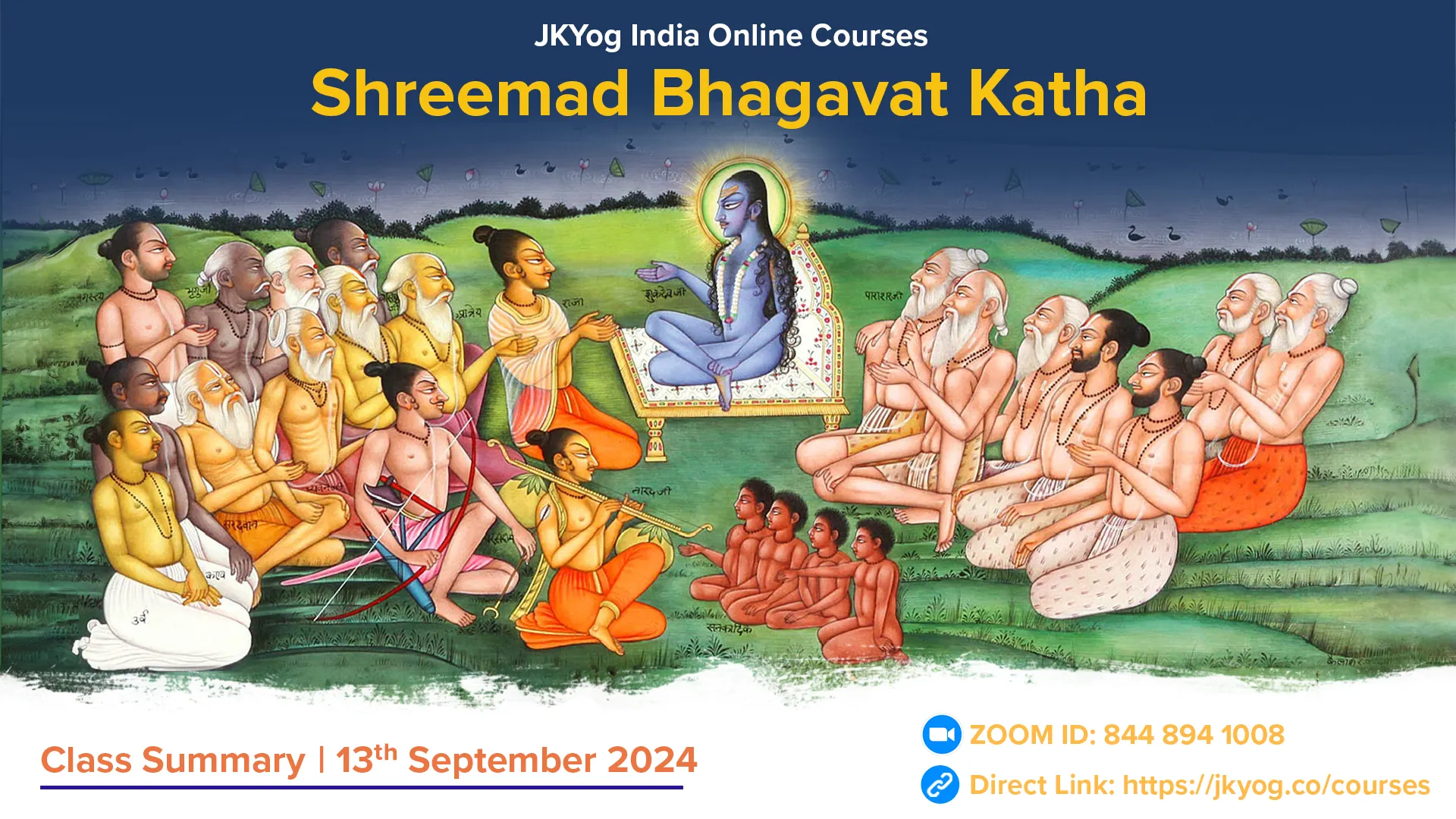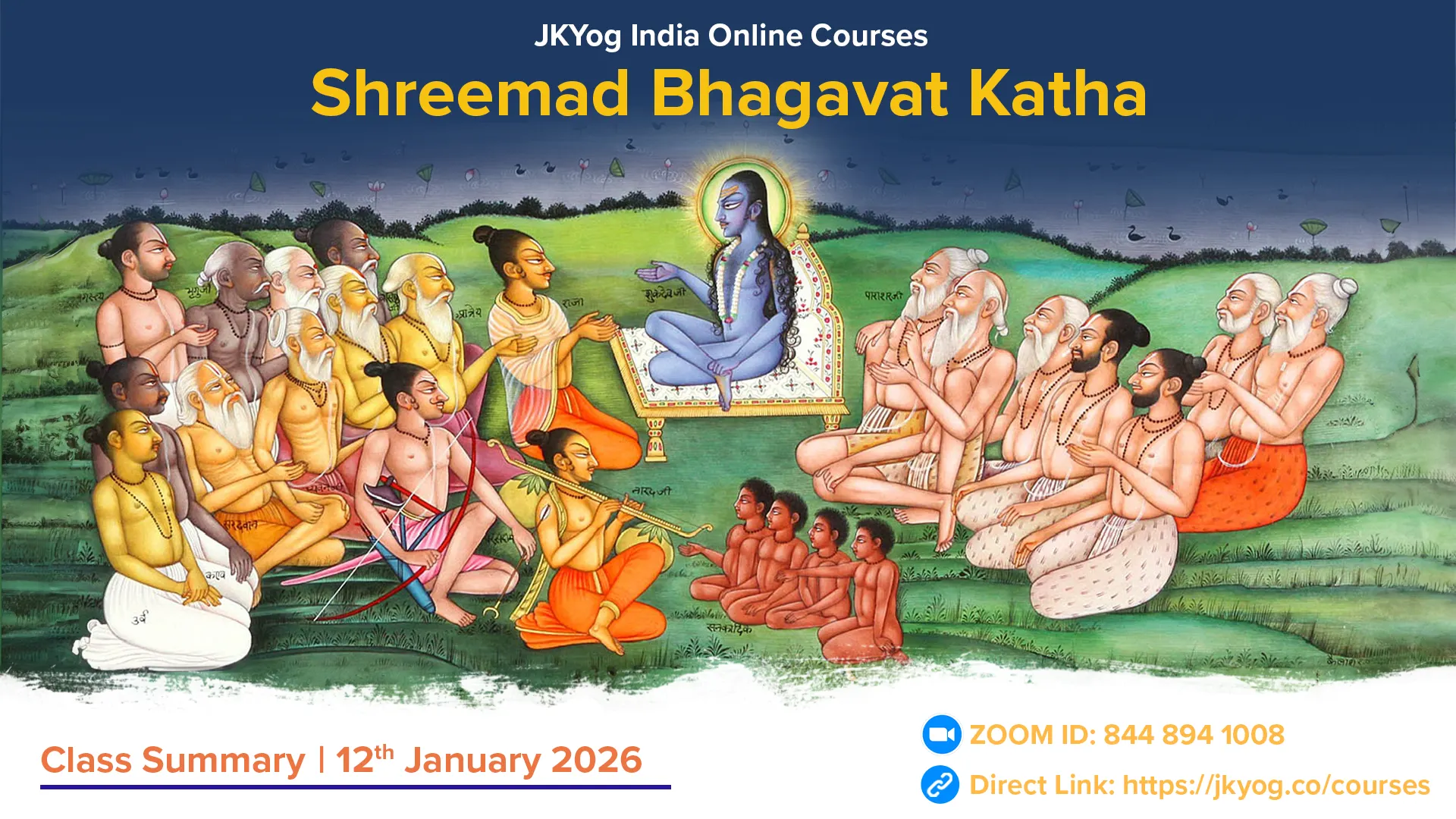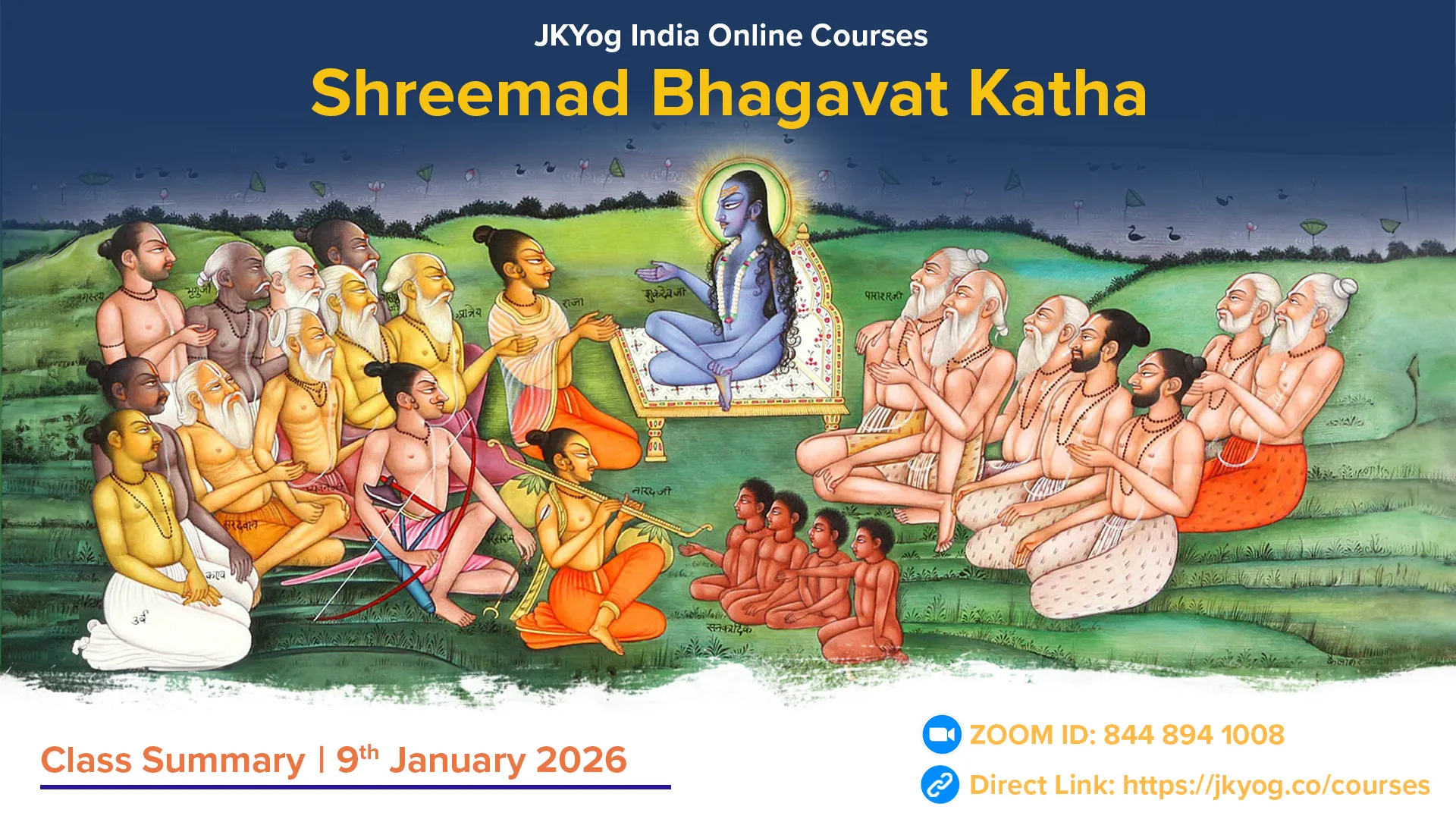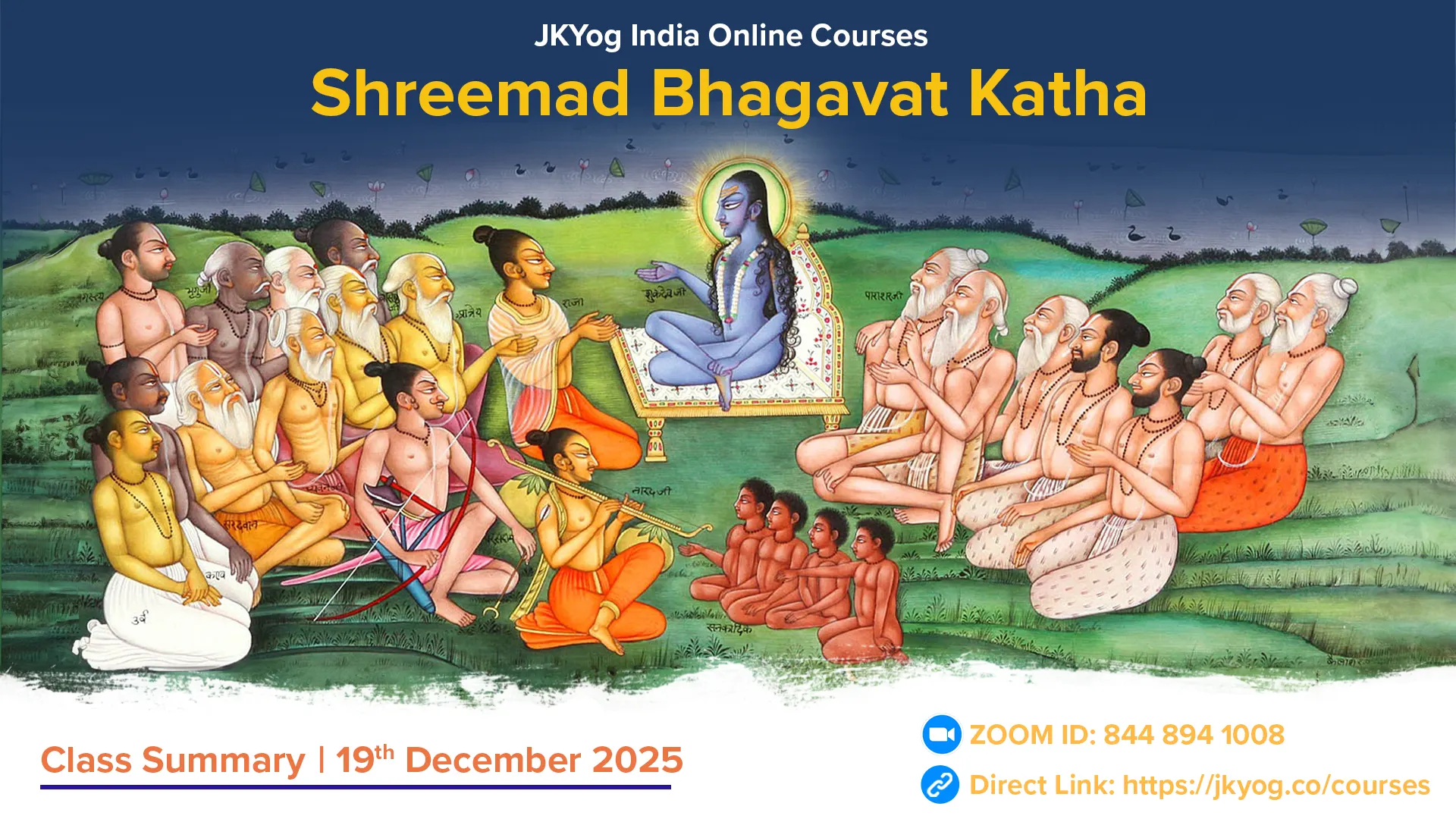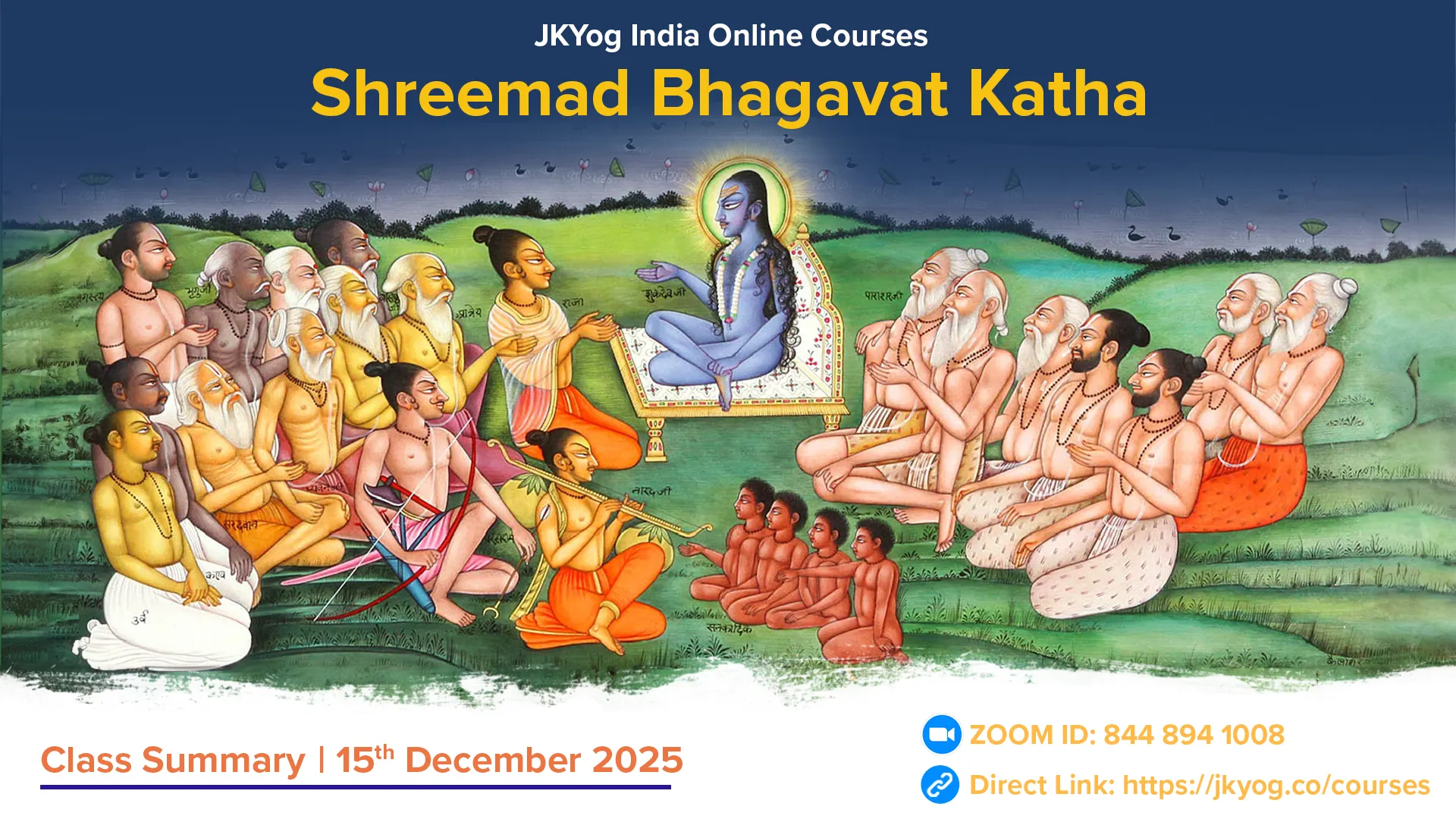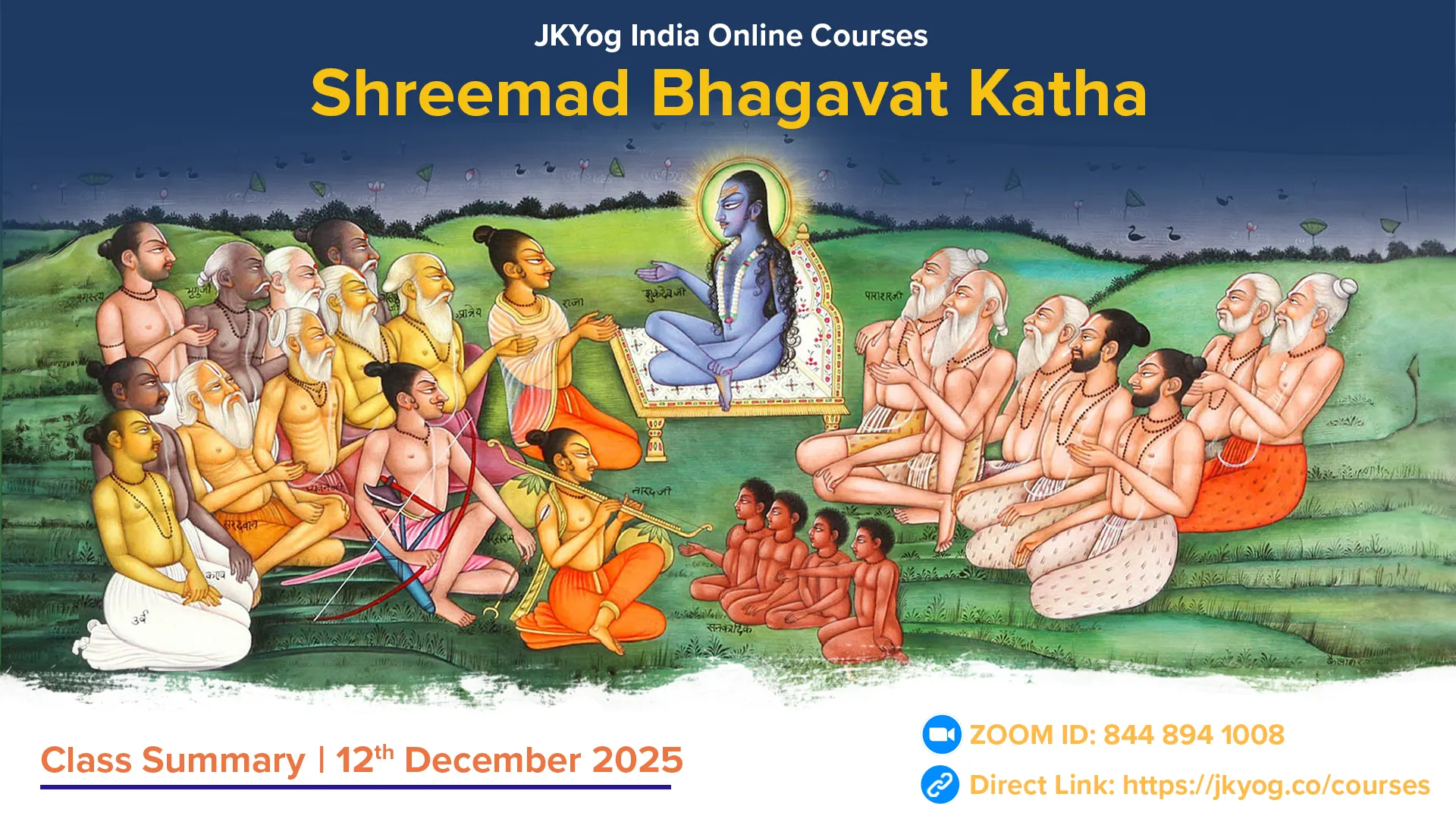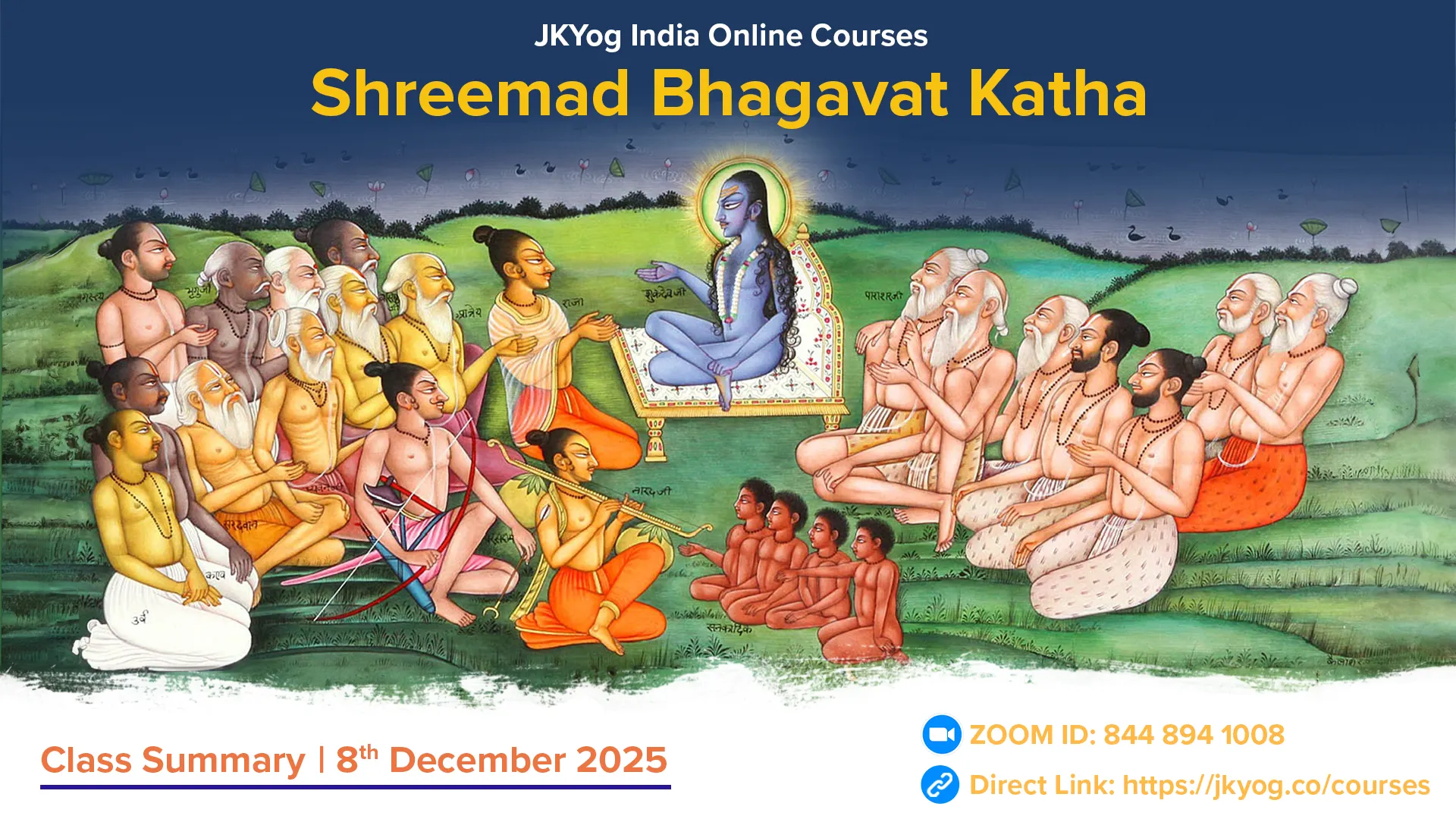Shreemad Bhagavat Mahapuran- Canto: 3, Chapters: 9 to 11
Brahmaji spends a long time searching for the source of His origin in the darkness. After eventually failing, He returns to His foundational lotus, controls His breath, and enters a state of deep meditation. After practising Yog for His full lifespan (divine hundred years), Brahmaji attains knowledge and witnesses His foundation illuminated within His heart. Brahmaji sees that in the waters of the great dissolution (Pralaya), Bhagwan Sheshji lies alone on a giant bed resembling a lotus stem. Sheshji's ten thousand hoods are spread out like an umbrella, and crowns adorn His heads. Brahmaji observes that from Bhagwan's navel emerges a lotus, and only five elements—water, sky, air, the lotus, and His own body—are visible. Nothing more is seen. Observing these five elements, Brahmaji praises Bhagwan and becomes immersed in the desire to create beings for the universe. He then begins to sing hymns of praise to Shree Hari.
Brahmaji says that he has recognised Bhagwan after a long time, and due to the influence of Maya, it is difficult for ordinary beings to comprehend His form. Bhagwan alone is the truth, and the form from which Brahmaji emerges from His navel lotus is the source of all incarnations. While glorifying Bhagwan, Brahmaji states that Bhagwan's true form is blissful and indivisible. Devotees who worship His lotus feet are freed from fear, sorrow, and greed. Through hearing and singing the stories and qualities of Bhagwan, humans can understand Him, and this is the path to liberation from worldly suffering. Brahmaji acknowledges that Bhagwan has revealed His divine form for His welfare. The sinful beings of the world fail to understand Bhagwan's form and suffer by becoming entangled in material desires. Until a being takes refuge in Bhagwan's feet, they will continue to face suffering, fear, and greed due to wealth, family, and other worldly possessions. Brahmaji prays to Bhagwan, asking for blessings and grace to carry out the task of creation. He further explains that Bhagwan, as Kaal (time), ends the lifespan of all beings and takes different incarnations according to His will. Finally, Brahmaji seeks Bhagwan's blessings for the creation of the universe.
Maitreyaji says that after praising Bhagwan according to the abilities of His mind and speech, Brahmaji became exhausted and fell silent. Bhagwan Madhusudan noticed that Brahmaji was fearful of the dissolution waters and troubled by the uncertainty regarding creation. Understanding the state of Brahmaji's mind, Bhagwan, with His profound voice, attempted to calm Brahmaji's distress. Bhagwan inspired Brahmaji to begin the process of creation, urging Him to abandon His despondency and engage in further penance and the practice of Bhagavat-jnana (divine knowledge). He explained that when Brahmaji, with devotion and a focused mind, perceives all the worlds within His heart, He will see the entire universe pervading Bhagwan and Bhagwan pervading the entire universe. When a being sees Bhagwan present in all creatures, they become free from ignorance and attain moksha (liberation). He assured Brahmaji that during the creation of the universe, His mind would not be deluded, and He would not be bound by sinful rajas (passion). Bhagwan also revealed that Brahmaji, seeing Him as beyond the elements, senses, qualities, and mind, would be assured of liberation. Finally, Bhagwan instructed Brahmaji to create the three worlds and beings as in the previous cycle and then disappear in His Narayan form.
Vidurji then asked Maitreyaji about the various types of creation that Brahmaji initiated after the disappearance of Bhagwan Narayan. He also requested Maitreyaji to answer all his other questions in sequence to clear his doubts, as Maitreyaji is the most knowledgeable among sages. Addressing Shaunakji, Sootji mentioned that Maitreyaji was extremely pleased with Vidurji's questions and began his reply. Maitreyaji explained that, as instructed by Bhagwan Shree Hari, Brahmaji focused his mind on Shree Narayan and performed penance for a hundred divine years. Brahmaji observed that due to the powerful winds of dissolution, the lotus from which he had emerged and on which he was seated and the waters were trembling. Through intense penance and self-realisation, Brahmaji's strength of wisdom increased, and he consumed the winds along with the waters. Then, noticing the sky-encompassing lotus on which he was seated, he thought, "I will recreate the worlds dissolved in the previous cycle from this lotus." With this thought, he divided the lotus into three parts: Bhuh, Bhuvah, and Svah. Though this lotus was sufficient to create the fourteen worlds or more, these three worlds are described as places for beings to experience the fruits of their actions, while those who perform selfless deeds attain Maha, Tapah, Janah, and Satyalok.
Vidurji asked Maitreyaji to explain in detail the concept of 'Time,' which he mentioned earlier as the divine power of the wondrous Vishvarupa Shree Hari. Maitreyaji explained that the transformation of objects is the manifestation of Kaal, and Bhagwan uses it as a medium to reveal His creation.
Prakrit and Vaikrit Creations
Creation has nine types, and the tenth type of creation arises from the distinction between Prakrit (natural) and Vaikrit(transformed) forms. The process of pralaya (dissolution) happens in three ways—through time, matter, and qualities.
Six Types of Prakrit Creations:
Bhagwan Shree Hari is behind the entire creation process. He assumes the form of Brahma by embodying rajogun (the quality of passion) and initiates creation. In the process of creation, six types of natural or fundamental Prakrit creations occur:
- First Creation (Mahattattva): The first creation, Mahattattva, arises when, by Bhagwan's inspiration, the qualities of sattva (goodness), rajas (passion), and tamas (ignorance) become imbalanced.
- Second Creation (Ahankar): From Ahankar, the five great elements (pancha mahabhutas), sensory organs (jnanendriyas), and action organs (karmendriyas) are produced.
- Third Creation (Bhutasarg): The creation of the class of subtle elements (tanmatras), which give rise to the five great elements, occurs in this stage.
- Fourth Creation (Indriyas): The creation of sensory and motor organs equipped with the powers of knowledge and action takes place.
- Fifth Creation (Devas): The deities who govern the senses and the mind are created from the sattvic ego.
- Sixth Creation (Avidya): In this creation of ignorance, five kinds of knots emerge—Tamishra, Andhatamishra, Tamas, Moha, and Mahamoh—which cover and distract the intellect of living beings.
Four Types of Vaikrit Creations:
- Seventh Creation (Sthavar): This is the creation of immobile beings like trees. It includes plants, herbs, creepers, bark-bound plants, vines, and trees. These beings lack the power of knowledge and can only sense touch, with each having a unique characteristic.
- Eighth Creation (Tiryak Yonis): The creation of animal and bird species, categorised into 28 types, occurs here. Due to the predominance of tamogun (ignorance), these beings lack foresight and intellectual power, focusing only on food, reproduction, and sleep. This group includes two-hoofed and single-hoofed animals and animals with five claws, such as dogs, jackals, wolves, and tigers. Birds like herons, vultures, quails, hawks, eagles, bears, peacocks, swans, cranes, chakwa birds, crows, and owls are part of this group.
- Ninth Creation (Humans): This single type of creation pertains to humans. The flow of nourishment in them goes from the mouth downwards. Humans are primarily driven by rajogun, engrossed in actions and mistaking material desires, which are inherently full of sorrow, for happiness.
- Tenth Creation (Divine Creation): This includes the creation of deities, ancestors, demons, gandharvas (celestial musicians), apsaras (heavenly maidens), yakshas, rakshasas, and other invisible beings.
The creations of immobile beings, animals and birds, humans, and the divine (devsarg) are classified as Vaikrit creations. Additionally, the creation of deities like those born from Mahattattva was previously categorised under Prakrit creation. The creation of sages like Sanatkumar, who are both Prakrit and Vaikrit, is also included in this classification.
Division of Time, including Yug, Manvantara and Kalpa
Paramanu (atom) is the smallest part of objects like the earth. It cannot be divided further, has no specific form, and does not combine with other atoms on its own. When several Paramanu combine, they appear as one unit to people, though they are distinct.
In its pure state, Paramanu is not affected by different states like pralaya (dissolution), has no perception of time, such as new or old, and does not distinguish between objects like pots, clothes, etc. By comprehending the subtle and vast nature of Paramanu, one can also understand the minuteness and vastness of time, which encompasses everything from the smallest unit to the cycles of creation and dissolution.
- Two Paramanu combine to form an Anu.
- Three Anu (six Paramanu) combine to create a Trasarenu, which can be seen floating in sunlight.
Measuring Time:
- The time it takes for the sun to pass through three trasarenus is called a Truti (8/13,500th of a second).
- 100 Truti equals one Vedh.
- Three Vedh equals one Lav.
- Three Lav equals one Nimesh (blink).
- Three Nimesh equals one Kshan (moment).
Further Divisions of Time:
- Five Kshan equals one Kashta.
- Fifteen Kashta equals one Laghu.
- Fifteen Laghu equals one Nadika (also called Dand).
- Two Nadikas equals one Muhurat.
Day and Night:
- Six or seven Nadikas form one Prahar (also called Yam), which is one-quarter of a human day or night, depending on the length of the day.
How do you calculate a Nadika?
A copper vessel is made weighing six palas (48 grams x 6 = 288 grams) which can hold one prastha of water (400 grams). A gold pin weighing four masha (4 grams) and approximately four fingers (around 8 cm) long is used to make a hole at the base of the vessel. The vessel is then placed in water. The time it takes for one prastha of water (400 grams) to fill the vessel and for it to sink is called one "Nadika."
- A day and a night are each divided into four prahars. Fifteen day-nights make one paksha, which comes in two forms: Shukla Paksha (waxing phase of the moon) and Krishna Paksha (waning phase of the moon).
- Shukla Paksha and Krishna Paksha make up a “month,” equivalent to one day and night for the Pitras(ancestors).
- Two months make a "season" (ritu), and six months form an "ayana" (half-year). There are two ayanas: Dakshinayana (southern journey of the sun) and Uttarayana (northern journey of the sun). Combined, Dakshinayana and Uttarayana constitute one day and night for the gods. In human terms, this is called a "year" or twelve months. The maximum lifespan for humans is said to be 100 years.
- Bhagwan Surya, the deity of time, oversees the movement of the sun, moon, constellations, and star systems, continuously orbiting the entire universe in twelve zodiac signs, from the smallest atoms to the largest cosmic cycles like samvatsara (solar year). Based on the sun, Jupiter, lunar months, and constellations, the year is divided into Samvatsara, Parivatsara, Idavatsara, Anuvatsara, and Vatsara.
Maitreya Muni says, "Vidurji, worship Suryadev, who governs these five types of years, and offer gifts to Him. Surya is the embodiment of Tejas (brilliance) among the five great elements and uses his time and energy to provide the power to germinate seeds and other substances. Surya roams the sky, diminishing the lifespan of humans due to their attachment and delusions."
Vidurji then said, "You have described the maximum lifespan of the gods, Pitras, and humans. Now, please describe the lifespan of sages like Sanak and others, who dwell beyond the three worlds and live for periods even longer than a Kalpa."
How Many Years Does Kaliyug Last?
Maitreyajii said: Satya Yug, Treta Yug, Dwapar Yug, and Kaliyug—these four Yugas, including their twilight periods (Sandhya) and intermediate periods (Sandhyansha), last for a total of 12,000 divine years of the gods. Among these, the Satya Yug has 4,000 divine years, Treta has 3,000, Dwapar has 2,000, and Kaliyug has 1,000 divine years. Each Yug is followed by a twilight period that is twice as long as the corresponding Yuga's duration, divided between the dawn (Sandhya) and the dusk (Sandhyansha) phases. These periods of time are calculated in hundreds of years, and the span between them is known as the Yug, according to those who understand time.
For example, Satya Yug consists of 4,000 divine years for the Yug itself and an additional 800 years for the twilight periods (Sandhya and Sandhyansha), totalling 4,800 divine years. Similarly, Treta Yug has 3,600 divine years, Dwapar Yug has 2,400, and Kaliyug has 1,200 divine years. A human year is equivalent to one day for the gods, so one year for the gods equals 360 human years. Based on this, Kaliyug lasts for 432,000 human years, Dwapar for double that, Treta for triple, and Satya Yug for quadruple that amount in human terms.
Beyond the Trilok (three worlds), from Maharlok to Brahmalok, one day of Brahma equals 1,000 Mahayugas (or four-yug cycles). This cycle continues as long as Brahma's day lasts. During one Kalpa, fourteen Manus reign. Each Manu rules for a period of 71 Chaturyugas (Yug cycles) and a little more, totalling 716 Yugs. During each Manvantara, different kings, Saptarishis, gods, Indra, and their followers, like the Gandharvas, rule and fulfil their duties. This daily creation of Brahma involves the creation of the three worlds and the birth of beings such as animals, birds, humans, ancestors, and gods, according to their respective karmas. Bhagwan, assuming the form of Manu and other deities, governs and sustains the universe during each Manvantara by taking refuge in sattva (purity). When Brahma's day ends, he accepts the Tamo Guna (quality of passion), halts the process of creation, and enters a state of rest. At that time, the entire universe dissolves into him.
- Satya Yug = 1,728,000 human years (4000 Devta years)
- Treta Yug = 1,296,000 human years (3000 Devta years)
- Dwapar Yug = 864,000 human years (2000 Devta years)
- Kaliyug = 432,000 human years (1000 Devta years)
- 1 Mahayug = 4,320,000 human years
- 71 Mahayugs = 1 Manvantara
- 14 Manvantaras = 1 Kalpa= 1 day of Brahma
- 360 Kalpas = 1 year of Brahma
- Brahma's lifespan = 100 years = 36,000 Kalpas
When the night of dissolution (Pralaya) arrives, the existence of the Sun and Moon comes to an end, and the three worlds (Bhu, Bhuva, Svah) merge into the body of Brahmaji. At this time, the entire universe begins to burn due to the fiery power of Bhagwan emanating from the mouth of Sheshji (the serpent deity). Disturbed by this intense heat, great sages and saints move from Maharlok to Janlok. During the Pralaya, the seven oceans overflow due to the fierce winds, drowning the three worlds.
In this deluge, Bhagwan Sheshshayi lies in Yog Nidra (yogic sleep) in the waters while the residents of Janlok sing His praises. The passage of Brahmaji's hundred-year lifespan seems to elapse in an instant due to the cycle of thousands of Chaturyugs (Yug cycles). Half of Brahmaji's lifespan is called a Parardha. The first Parardha has already ended, and the second Parardha is currently underway.
- Current Age of Brahmaji: Brahmaji is currently 51 years old. Which means he has completed 50 years or 18,000 Kalpas.
- First Kalpa: The first Kalpa is called Brahma Kalpa. Scholars refer to it as Shabda Brahma.
- Previous Kalpa: The Kalpa before the present Kalpa was called Padma Kalpa.
- Current Kalpa: The current Kalpa marks the beginning of the second Parardha, which is called Shwet Varaha Kalpa and is named after Bhagwan Varaha.
- Current Manvantar: We are currently in the 7th Manvantara of Shwet Varaha Kalpa, known as Vaivasvata Manvantara.
The time from the smallest atom to the entire dual Parardha is like a mere moment for Bhagwan Shree Hari. The power of time, which extends from the atom to the vast Parardha, does not affect Bhagwan Shree Hari. It only governs those beings entangled in physical bodies and ego.
The universe, which comprises the eight primal elements (Prakriti, Mahattattva, Ahankar, and the five Tanmatras) along with the ten senses, mind, and the five great elements (Pancha Mahabhuta), is 500 million Yojanas in extent. Outside this, there are seven layers of coverings, each ten times greater than the previous one.
That Supreme God from whose pores countless universes emerge is known as the Akshara Brahman (the Imperishable Absolute). He is the ultimate cause of all causes and represents the supreme form of Bhagwan Vishnu, also known as the First Purush, Karanodakshayi Vishnu, or Maha-Vishnu.
Summary: JKYog India Online Class- Shreemad Bhagavat Katha [Hindi]- 13.09.2024

